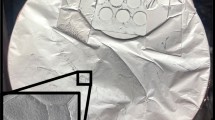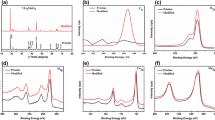Abstract
Li metal electrodes have the potential to increase the energy density of conventional lithium-ion batteries by up to 60%. However, challenges regarding the cycling efficiency and safety of these electrodes still remain. Effective surface treatments seem to be a promising approach for resolving issues such as dendrite formation or excessive reaction with the electrolyte. LiF has been reported to exhibit most of the properties required of a coating material in this context, offering high electro-/chemical stability, mechanical strength, high surface energies, etc. Nevertheless, contradicting reports on the effectiveness of LiF coatings to improve the cycling efficiency of Li metal electrodes raise doubts on its effectiveness to protect the Li metal surface. The mechanism of protection for this material is also not well understood. Thus, a comparative study was conducted, selecting three different approaches for the synthesis of a LiF coating on Li metal and following with detailed electrochemical analysis. Using the same experimental setup for all samples enabled direct comparison between the selected coatings, and subsequently, a reliable evaluation on the effectiveness of LiF as protective coating.
Graphic abstract















Similar content being viewed by others
References
Liu J, Bao Z, Cui Y, Dufek EJ, Goodenough JB, Khalifah P, Li Q, Liaw BY, Liu P, Manthiram A, Meng YS, Subramanian VR, Toney MF, Viswanathan VV, Whittingham MS, Xiao J, Xu W, Yang XQ, Zhang JG (2019) Pathways for practical high-energy long-cycling lithium metal batteries. Nat Energy 4:180–186. https://doi.org/10.1038/s41560-019-0338-x
Xiang J, Yang L, Yuan L, Yuan K, Zhang Y, Huang Y, Lin J, Pan F, Huang Y (2019) Alkali-metal anodes: from lab to market. Joule 3:2334–2363. https://doi.org/10.1016/j.joule.2019.07.027
Chen KH, Wood KN, Kazyak E, LePage WS, Davis AL, Sanchez AJ, Dasgupta NP (2017) Dead lithium: mass transport effects on voltage, capacity, and failure of lithium metal anodes. J Mater Chem A 5:11671–11681. https://doi.org/10.1039/C7TA00371D
Delaporte N, Wang Y, Zaghib K (2019) Pre-treatments of lithium foil surface for improving the cycling life of li metal batteries. Front Mater 6:267. https://doi.org/10.3389/fmats.2019.00267
Ko J, Yoon YS (2019) Recent progress in LiF materials for safe lithium metal anode of rechargeable batteries: Is LiF the key to commercializing Li metal batteries? Ceram Int 45:30–49. https://doi.org/10.1016/j.ceramint.2018.09.287
Chen L, Chen KS, Chen X, Ramierez G, Huang Z, Geise N, Steinrück HG, Fisher BL, Shahbazian-Yassar R, Toney MF, Hersam MC, Elam JW (2018) Novel ALD chemistry enabled low-temperature synthesis of lithium fluoride coatings for durable lithium anodes. ACS Appl Mater Interfaces 10:26972–26981. https://doi.org/10.1021/acsami.8b04573
Zhu Y, He X, Mo Y (2015) Origin of outstanding stability in the lithium solid electrolyte materials: insights from thermodynamic analyses based on first-principles calculations. ACS Appl Mater Interfaces 7:23685–23693. https://doi.org/10.1021/acsami.5b07517
Zhao J, Liao L, Shi F, Lei T, Chen G, Pei A, Sun J, Yan K, Zhou G, Xie J, Liu C, Li Y, Liang Z, Bao Z, Cui Y (2017) Surface fluorination of reactive battery anode materials for enhanced stability. J Am Chem Soc 139:11550–11558. https://doi.org/10.1021/jacs.7b05251
Jäckle M, Groß A (2014) Microscopic properties of lithium, sodium and magnesium battery anode materials related to possible dendrite growth. J Chem Phys 141:174710. https://doi.org/10.1063/1.4901055
Ozhabes Y, Gunceler D, Arias TA, (2015) Stability and surface diffusion at lithium-electrolyte interphases with connections to dendrite suppression. http://arxiv.org/abs/1504.05799v1
He M, Guo R, Hobold GM, Gao H, Gallant BM (2020) The intrinsic behavior of lithium fluoride in solid electrolyte interphases on lithium. PNAS 117:73–79. https://doi.org/10.1073/pnas.1911017116
Aurbach D, Zinigrad E, Cohen Y, Teller H (2002) A short review of failure mechanisms of lithium metal and lithiated graphite anodes in liquid electrolyte solutions. Solid State Ion 148:405–416. https://doi.org/10.1016/S0167-2738(02)00080-2
Lin D, Liu Y, Chen W, Zhou G, Liu K, Dunn BS, Cui Y (2017) Conformal lithium fluoride protection layer on three-dimensional lithium by nonhazardous gaseous reagent freon. Nano Lett 17:3731–3737. https://doi.org/10.1021/acs.nanolett.7b01020
Yuan Y, Wu F, Bai Y, Li Y, Chen G, Wang Z, Wu C (2019) Regulating Li deposition by constructing LiF-rich host for dendrite-free lithium metal anode. Energy Storage Mater. 16:411–418. https://doi.org/10.1016/j.ensm.2018.06.022
Lang J, Long Y, Qu J, Luo X, Wei H, Huang K, Zhang H, Qi L, Zhang Q, Li Z, Wu H (2019) One-pot solution coating of high quality LiF layer to stabilize Li metal anode. Energy Storage Materials 16:85–90. https://doi.org/10.1016/j.ensm.2018.04.024
Yuan Y, Wu F, Chen G, Bai Y, Wu C (2019) Porous LiF layer fabricated by a facile chemical method toward dendrite-free lithium metal anode. J Energy Chem 37:197–203. https://doi.org/10.1016/j.jechem.2019.03.014
Wang G, Xiong X, Xie D, Fu X, Lin Z, Yang C, Zhang K, Liu M (2019) A scalable approach for dendrite-free alkali metal anodes via room-temperature facile surface fluorination. ACS Appl Mater Interfaces 11:4962–4968. https://doi.org/10.1021/acsami.8b18101
Ko J, Yoon YS (2019) Lithium fluoride layer formed by thermal evaporation for stable lithium metal anode in rechargeable batteries. Thin Solid Films 673:119–125. https://doi.org/10.1016/j.tsf.2019.01.048
Fan L, Zhuang HL, Gao L, Lu Y, Archer LA (2017) Regulating Li deposition at artificial solid electrolyte interphases. J Mater Chem A 5:3483–3492. https://doi.org/10.1039/C6TA10204B
Shirley DA (1972) High-resolution x-ray photoemission spectrum of the valence bands of gold. Phys Rev B 5:4709. https://doi.org/10.1103/PhysRevB.5.4709
Tougaard S (1998) Universality classes of inelastic electron scattering cross-sections. Surf Interf Anal 25:137–154. https://doi.org/10.1002/(SICI)1096-9918(199703)25:3%3c137::AID-SIA230%3e3.0.CO;2-L
Scofield JH (1976) Hartree-Slater subshell photoionization cross-sections at 1254 and 1487 eV. J Electron Spectroscop Relat Phenom 8:129–137. https://doi.org/10.1016/0368-2048(76)80015-1
Lee JZ, Wynn TA, Schroeder MA, Alvarado J, Wang X, Xu K, Meng YS (2019) Cryogenic focused ion beam characterization of lithium metal anodes. ACS Energy Lett 4:489–493. https://doi.org/10.1021/acsenergylett.8b02381
Wagner CD, Naumkin AV, Kraut-Vass A, Allison JW, Powell CJ, Rumble JR (2003) NIST Standard Reference database 20, Version 3.4 (web version) (http:/srdata.nist.gov/xps/)
Tomar BS, Shahin A, Tirumkudulu MS (2020) Cracking in drying films of polymer solutions. Soft Matter 16:3476–3484. https://doi.org/10.1039/C9SM02294E
Markowitz MM, Boryta DA (1962) Lithium metal-gas reactions. J Chem Eng Data 7:586–591. https://doi.org/10.1021/je60015a047
Smyrl NR, Fuller EL, Powell GL (1983) Monitoring the heterogeneous reaction of LiH and LiOH with H2O and CO2 by diffuse reflectance infrared fourier transform spectroscopy. Appl Spectrosc 37:38–44
Wood KN, Kazyak E, Chadwick AF, Chen KH, Zhang JG, Thornton K, Dasgupta NP (2016) Dendrites and pits: untangling the complex behavior of lithium metal anodes through operando video microscopy. ACS Cent Sci 2:790–801. https://doi.org/10.1021/acscentsci.6b00260
Aurbach D, Zaban A (1993) Impedance spectroscopy of lithium electrodes – Part 1. General behavior in propylene carbonate solutions and the correlation to surface chemistry and cycling efficiency. J Electroanal Chem 348:155–179. https://doi.org/10.1016/0022-0728(93)80129-6
Zaban A, Zinigrad E, Aurbach D (1996) Impedance spectroscopy of li electrodes. 4. A general simple model of the li-solution interphase in polar aprotic systems. J Phys Chem 100:3089–3101. https://doi.org/10.1021/jp9514279
Jung R, Metzger M, Maglia F, Stinner C, Gasteiger HA (2017) Oxygen release and its effect on the cycling stability of LiNixMnyCozO2 (NMC) cathode materials for Li-ion batteries. J Electrochem Soc 167:A1361–A1377. https://doi.org/10.1149/2.0021707jes
Acknowledgements
This activity has received funding from the Mobility of the Future program within the project LIANO (Grant Agreement No. 873376). Mobility of the Future is a research, technology, and innovation funding program of the Republic of Austria, Ministry for Climate Action. The Austrian Research Promotion Agency (FFG) has been authorized for the program management.
Author information
Authors and Affiliations
Contributions
Conceptualization: AB; methodology: AB; general experimental investigation and electrochemical analysis: MGS and AB; characterization XPS: MS and AF; characterization XRD: RH; characterization SEM: NZ; writing—original draft preparation: AB; writing—review and editing: GF and RGN; funding acquisition: AR and RGN; supervision: GF and AB.
Corresponding author
Ethics declarations
Conflict of interest
The authors have no relevant financial or non-financial interests to declare. The authors have no conflicts of interest to declare that are relevant to the content of this article. All authors certify that they have no affiliations with or involvement in any organization or entity with any financial interest or non-financial interest in the subject matter or materials discussed in this manuscript. The authors have no financial or proprietary interests in any material discussed in this article.
Additional information
Publisher's Note
Springer Nature remains neutral with regard to jurisdictional claims in published maps and institutional affiliations.
Supplementary Information
Below is the link to the electronic supplementary material.
Rights and permissions
About this article
Cite this article
Stadt, M.G., Hamid, R., Zhang, N. et al. Assessing LiF as coating material for Li metal electrodes. J Appl Electrochem 52, 339–355 (2022). https://doi.org/10.1007/s10800-021-01620-7
Received:
Accepted:
Published:
Issue Date:
DOI: https://doi.org/10.1007/s10800-021-01620-7




